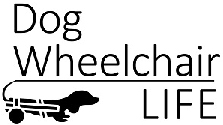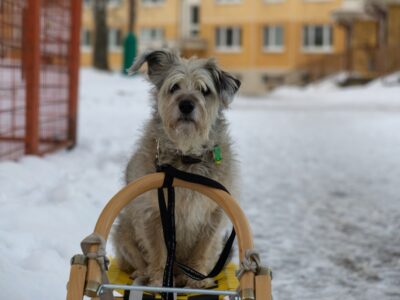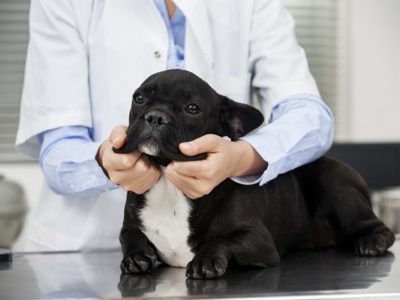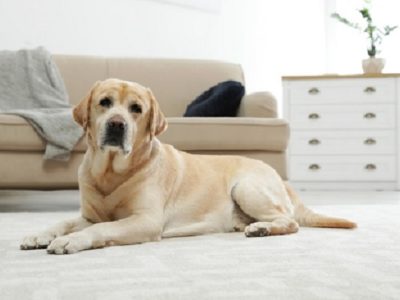
Table of Contents[Hide][Show]
Intervertebral disc disease in dogs is an unfortunately common cause of back pain, hind end weakness and paralysis. An estimated 2 percent of dogs will be affected by IVDD during their lifetime. The percentage is even higher for breeds prone to the condition.
My goal for this article is to help you understand the two types of IVDD, the symptoms, treatment options and how to care for your dog at home. As a pet owner, I want you to have a good understanding of your dog’s condition and be armed with important questions to ask your vet.
What is Intervertebral disc disease?
IVDD is a degenerative condition of the spine where the discs in your dog’s back age faster than they should normally.
The first time most pet owners hear about the disorder is during an emergency. It usually happens after your dog does something routine, like jump off the couch or hop down some steps. But instead of running off to play as usual, your pup is in pain and having a hard time moving.
Most people head to the vet at this point. That’s where you learn that your dog’s had an injury to the spine called a ruptured, herniated or slipped disc, due to IVDD.
At first glance, the injury looks like a random incident, but when you dig deeper, you find the disease process began long before this event.
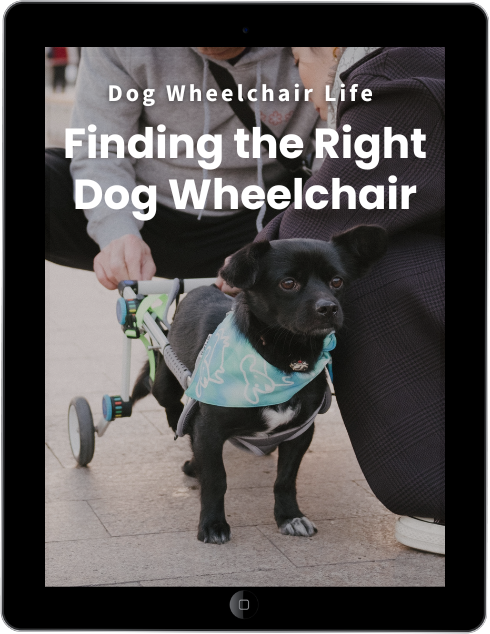
eBook
Find The Right Dog Wheelchair For Your Pet
Your dog has a mobility problem, and you want to buy a wheelchair. But do you know what kind of cart will work best for your dog’s individual needs? After a decade of teaching pet owners how to make the right choice, I put the information into an eBook!
Here’s a short description of the spine to explain what happens.
The spinal column is made up of small bones called vertebrae which are stacked in a column. The vertebrae are connected by discs. Each disc has a jelly-like fluid center that serves as a cushion between the bones.
IVDD causes the discs to breakdown prematurely. For some breeds it happens because the disc material dries out and hardens. And for other dogs the discs soften to a point where the fluid inside bulges or ruptures.
According to Veterinary Partner™ the most common areas for IVDD disc problems are in the middle of the spine at T11-T12 or at L2 – L3 in the lower back. Cervical (neck) herniations happen only 15 percent of the time, but nearly 80 percent of the patients are: dachshunds, beagles, and poodles.
The two types of IVDD
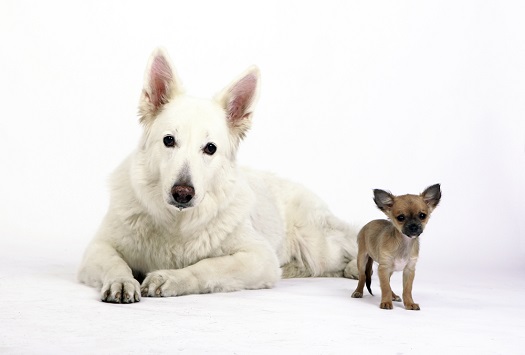
Intervertebral disc disease comes in two distinct forms called, Hansen Type I and Hansen Type II. Each has a different cause and affects different breeds.
Hansen Type I
This is the most common type of IVDD in dogs. Susceptible pups are usually young or middle-aged (3-6 years old) chondrodystrophic breeds. That means they have short stubby legs and long backs.
Part of the reason these dogs are predisposed is due to their body shape. They carry a large amount of weight on a small frame.
There’s also a genetic component to this form of IVDD that researchers are currently studying. A gene mutation has been identified that makes some breeds more vulnerable.
Dogs with Hansen Type I have disc material that dries out earlier in life than dogs without the condition.
It causes problems that range from mild inflammation to complete paralysis, depending on the severity of the disease.
Here’s a list of breeds prone to Hansen Type I IVDD:
- Dachshunds
- Bulldogs
- French bulldogs
- Corgis
- Basset Hounds
- Pekingese
- Shih Tzus
- Beagles
- Cavalier King Charles Spaniels
- Cocker Spaniels
- Miniature and Toy Poodles
- Lhasa Apsos
Other suspected breeds are:
- Chihuahuas
- Bichon Frise
- Jack Russell Terriers

Get the Essential Guide
The Essential Guide of Products for Handicapped Dogs e-book is a labor of love for me. I wrote it to answer your most pressing questions about where to find the best products for your wheelchair dog. You’ll find products you didn’t know existed and each will improve your dog’s quality of life. Print a copy and keep it by your side.
Hansen Type II Disc Disease
Dogs who develop Type II disc disease tend to be older large breed canines like German shepherds. Their disease develops at a slower rate than Type I dogs. And instead of their discs drying out, Type II dogs have discs that soften until they’re unable to cushion the spine. This causes the disc to bulge or rupture and put too much pressure on the spinal cord.
Breeds prone to Hansen Type II are:
- German Shepherds
- Labrador Retrievers
- Doberman Pinchers
The 5 stages of Intervertebral Disc Disease

Whether your dog has Hansen Type I or Type II disease, your veterinarian will assign a stage classification to your pup’s condition. There are 5 stages of IVDD and each refers to the symptoms your pet’s experiencing.
Stage 1 refers to mild symptoms while Stage 5 can include complete paralysis. Dogs are able to move up and down the classification chart as their symptoms improve or get worse. Assigning a number to your dog’s symptoms is helpful to you and your vet. It enables the veterinarian to prescribe a treatment plan and it gives insight about your dog’s prognosis in the future.
Symptoms of the 5 IVDD stages
- 1 – Your dog shows signs of mild pain in the back or neck, but is able to walk normally. Signs include: stiffness, hesitation to lift their head or refusing to jump on and off furniture.
- 2 – Dogs are unsteady on their feet. They are in noticeable pain that includes: crying when touched, panting, trembling and an overall hesitancy to move. Some dogs stand with an arched back and appear lethargic.
- 3 – Your dog isn’t able to walk or stand without help. There are signs of pain along with weakness in their limbs. They have loss of muscle control and knuckle under their paws.
- 4 – Dogs are in severe pain and can’t move the affected limbs. They might also lose control of their bladder.
- 5 – Your dog experiences paralysis in the two rear limbs or the two front legs. There’s a loss of deep pain sensations along with incontinence of the bladder and bowels.
Dogs experiencing any pain or weakness in their back, neck or limbs should be seen by a veterinarian as soon as possible.
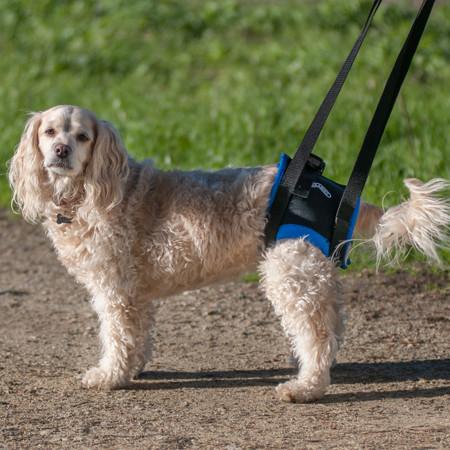
My favorite harnesses for disabled dogs.
Video: How To Express Your Dog’s Bladder
What to expect when you see your veterinarian
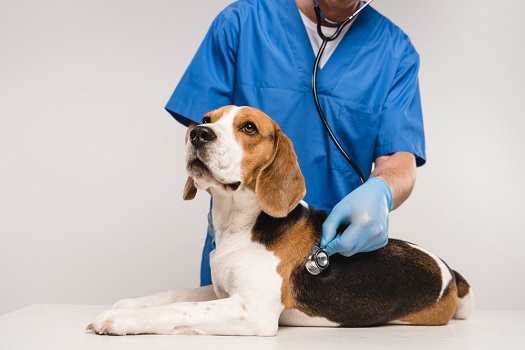
If you suspect your dog has symptoms of IVDD it’s important to make an appointment with your vet right away. Dogs who receive early intervention, are more likely to heal and keep their disease in check.
Once at your vet’s office the process will begin with a physical exam of your dog and a diagnostic workup to confirm disc disease and rule out other problems. Conditions like a spinal tumor, an infection or a fibrocartilaginous embolism (FCE stroke) have similar symptoms.
The initial tests for IVDD include the exam, x-rays and bloodwork.
Your dog could also be referred to a veterinary neurologist. This exam will include an evaluation of their gait, posture, pain level and mental status.
Dogs are also checked for: weakness, how they hold their head, the sensations they feel and whether it hurts more to walk up stairs or down. Each detail fits together like a map so the specialist can pinpoint which part of the spine is damaged.
An MRI or CT scan are commonly ordered as well. Both are high-imaging tests that take detailed pictures of the layers of your dog’s spine.
They help in evaluating the severity of the spinal injury and layout a plan for treatment.
One of the main goals of neurology exam is to determine whether or not your dog is a candidate for spine surgery.
Surgery vs. conservative treatment
Many times, the treatment plan for an IVDD dog includes surgery to repair a ruptured or bulging disc.
The best candidates tend to be dogs who can’t walk, but have deep pain sensations in at least one limb. Deep pain sensation is the awareness of pain in the skin, muscles and joints. It’s a hopeful indicator that the nerves in the spinal cord are communicating with the brain.
Research says the success rate for spine surgery on dogs in this category is as high as 90 percent.
The second-best surgical candidates are dogs who can’t walk, have no pain sensations, but have been paralyzed for 48 hours or less. These dogs have a surgery success rate of 50-60 percent.
That’s another reason why it’s important to take your dog to the vet as soon as you see signs of IVDD.
Logan’s successful recovery
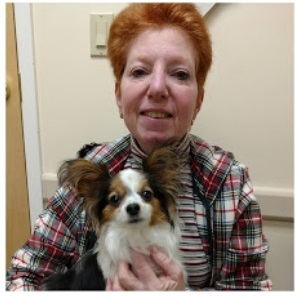
Here’s a story about the benefits of early surgical intervention along with dedicated follow up care by a dog’s owner.
Logan is a Papillion who suffered a ruptured disc after running around the yard, playing with his pet mom’s granddaughter. It was the day after Valentine’s Day 2018. Logan was 4-years-old.
Linda Pintoff is Logan’s devoted pet mom. Here how she explains their story.
“Logan was fine the evening after he played with my granddaughter, but the next morning he couldn’t jump off the bed. He looked worried so I carried him downstairs and got breakfast ready for him and my other dog Jackson.
Logan just looked at his bowl on the floor. I picked it up higher to his face and he was able to eat. But then he didn’t want to go down the steps to the yard. I knew something was wrong.”
By 2pm that day Logan had an exam with his regular vet, a neurological workup with a specialist, an MRI and hemilaminectomy surgery to relieve the pressure on his spine.
He was in the hospital for 5 days. When Linda took Logan home, he couldn’t walk on his own.
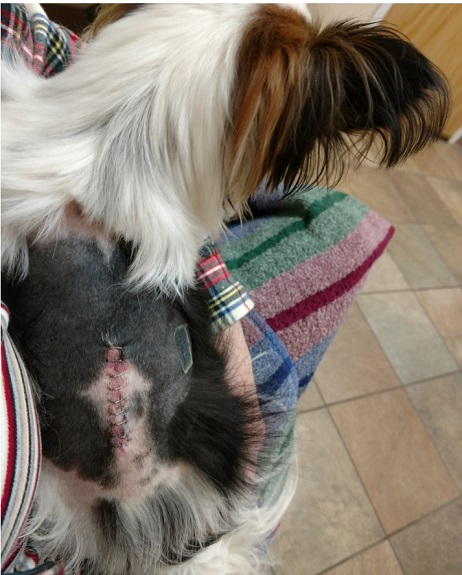
The little dog was on strict crate rest for a month. Logan’s vet taught Linda how to do slow range-of-motion exercises with him to keep him from losing muscle tone. When he felt better he started laser therapy and treatment with a canine physical therapist. Between sessions, Linda continued with exercises at home.
At 2 ½ months post-surgery, Logan was able to stand on his own and at 3 ½ months he could go for a walk. Today Logan continues to do physical therapy and acupuncture. He can walk and run and has regained control over his bowels.
The conservative approach
If your dog isn’t a candidate for surgery, don’t fret. You can still manage their care with a conservative approach. It’s a treatment plan that combines medication and strict crate rest.
The treatment plan is also a good option for people who can’t afford spine surgery for their pet or live in an area where surgery isn’t available.
How conservative treatment got its start
In 2002 one of my heroes, Linda Stowe, read a story posted in an online chat group for Dachshund lovers. It told about a Doxie named Dodger who was diagnosed with IVDD. Dodger was brought to the veterinarian and euthanized. At the time, the only options given to pet owners were surgery or euthanasia.
The story touched Linda’s heart. She immediately went about researching everything she could find about disc disease in dogs. The research led to the conclusion that a nonsurgical approach to treating IVDD could have a successful outcome.
I’ll warn you this approach is demanding. It calls for complete 100% crate rest to allow a dog’s spine to heal from an IVDD episode. Dogs are confined to a crate or X-pen 24 hours a day for 8 weeks. And while they’re resting a combination of steroids and medications to manage pain are given.
With her knowledge in hand, Linda developed literature for veterinarians and distributed them everywhere. Today conservative treatment for IVDD dogs is part of veterinary training and used in many countries around the world. Linda is credited with saving the lives of countless dogs.
Read more about the conservative approach at the Dodgerslist website.
How you can help your dog
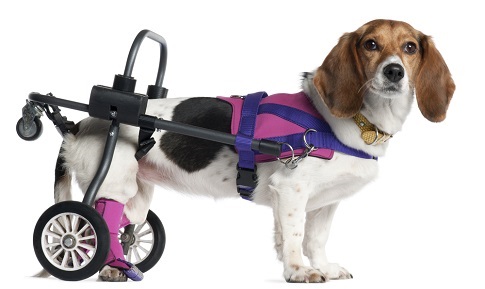
No matter where your IVDD dog is on the scale of disc disease there are ways you can help.
Start with your dog’s lifestyle:
- Make sure your dog stays at a healthy weight.
- Ask your vet if you should add a supplement for good joint health.
- Provide your dog with regular exercise like a daily walk. Make sure it’s appropriate for their age and health.
- Curb your IVDD prone dog from jumping on and off furniture. Invest in an indoor ramp.
Add a mobility device:
- Dog wheelchairs
- Mobility scooter
- Strollers and trailers
- Dog skates
- Support/Lifting harnesses and slings
- Braces to support hips, knees and elbows
- Drag or scoot bags
Start a rehab program:
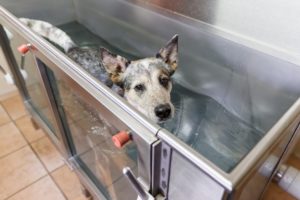
Canine physical therapy is relatively new, but its success in helping pets is amazing. From range-of-motion exercises to balance balls, underwater treadmills, and water therapy in specially heated pools, IVDD dogs are regaining their strength and mobility.
Linda Pintoff wrote this about her pup’s experience.
“Logan had to wait a month to heal fully and then he started rehab on an underwater treadmill. We also did laser treatments, massage and exercises for range of motion.
He had physical therapy twice a week for about 3 months and one day when I had him out in the backyard working with him in a sling, he seemed to have a glimmer of strength in his back legs.
The next day I told his physical therapist. She checked his reflexes and he had the beginning of sensation coming back. Over the next few months gradually he was able to stand and then walk clumsily. What a beautiful sight.”
At-home exercises
Many pet families do physical therapy at home. If this is something you’d like to start, my recommendation is to begin with an easy floor exercise like passive range-of-motion.
Talk with your vet before starting any physical therapy exercises with your dog.
Range-of-motion:
Do this exercise ONLY if your dog’s limbs can be moved manually in all directions, within normal range:
- Have your dog lie on their side.
- Gently stretch and flex the front and back limbs and move them in a circular motion. It should look like they’re taking a slow, easy bike ride.
- First circle the front limb going forward and then circle backwards. Repeat 5 times.
- Repeat the movement on the hind leg doing 5 circular movements.
- Gently help your dog position to the other side. Once they’re lying in a comfortable position, circle the front and back limbs on this side. These are easy, slow motions.
Range-of-motion helps the joints stay limber and it can improve function.
Light massage:
Another rehab technique you can do at home, once you get permission from your vet, is massage therapy. Massage enhances muscle tone and increases circulation.
Here’s how to start.
Help your dog lie on one side. Then softly rub and massage each major muscle group. Start at the shoulders, then go to the front limbs and slowly move down to the hind end and rear legs. This isn’t a deep tissue massage! It’s a slow gentle rub down. Once you’ve finished a side, help your dog roll to the opposite side and repeat the process.
Penny’s home rehabilitation
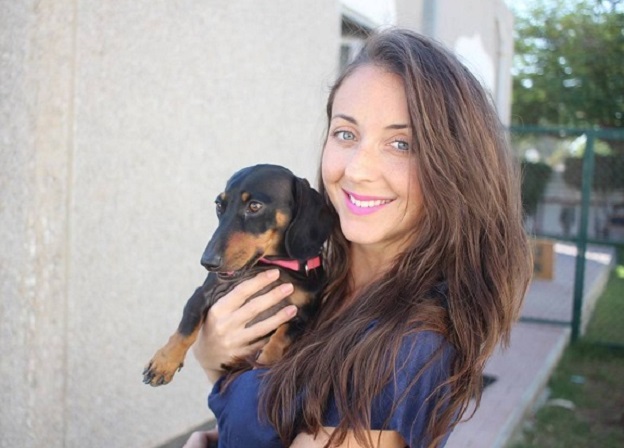
Sally and her dachshund Penny live in Bahrain, which is an island in the Middle East. When Penny was diagnosed with Stage 5 IVDD, there were no rehab centers to help.
At the suggestion of their veterinarian, Sally started to watch videos about canine physical therapy. She worked with Penny to do short 5-minute sessions every day that included massage and simple rehab movements.
When Penny got stronger, Sally increased the number of therapy sessions they did each day.
A few weeks into the routine, Penny began to wag her tail. (This is a very important sign if you have a paralyzed dog). At 4-6 weeks, the little Dachshund was able to move her legs.
Finally, after 5 months of daily PT, Penny was able to walk on her own.
Options
IVDD dogs have lots of options to keep their bodies strong and as healthy as possible. Be sure to discuss any of the topics in this article with your dog’s vet before implementing them. Every case of paralysis is unique, and your vet knows your dog’s condition best.
